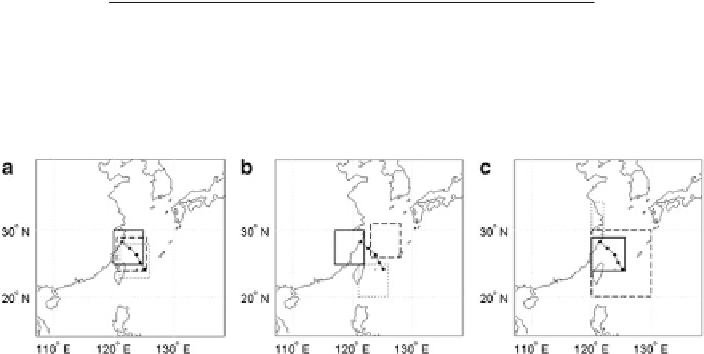Geoscience Reference
In-Depth Information
Table 24.1
The similarities among the energy distributions
obtained at 30, 60, and 120-km resolutions for TC Matsa (2005),
TC Meari (2004), and TC Mindulle (2004)
30 and 60 km
60 and 120 km
TC Matsa
0.70
0.78
TC Meari
0.55
0.75
TC Mindulle
0.49
0.72
Fig. 24.2
Verification areas for different designs. The
solid
rectangles in panel (
a
), (
b
), and (
c
)
are the verification areas for schemes A, D, and G respectively, while the
dashed
rectangles are
for schemes B, E, and H respectively, the
dotted
rectangles are for C, F, and I respectively. The
observation tracks of the cyclone are also shown in the center of the domain (From
Zhou and
Mu 2011
)
favorable for CNOP to display the nonlinear information, which play an important
role in the evolution of the initial perturbations, thus, as far as the computation
condition is permitted, using the CNOP method at a high resolution to identify the
sensitive areas may be more beneficial in targeted observations for tropical cyclone
predictions.
24.3.3
Sensitivity of CNOP Sensitive Areas with Respect
to the Verification Area Design
As indicated in Sect.
24.2.1
, the CNOPs also depend on the verification area design
(namely, different parameter
P
, and this has been studied in the paper of
Zhou and
Mu
(
2011
). The tropical cyclone Rananim, which occurred in the northwest Pacific
Ocean in 2004, is studied.
The design of the verification area is as follows. First, they defined a control
design in which the verification area includes the real cyclone tracks (the best storm
tracks) during the integral time period: scheme B (Fig.
24.2
a, dashed rectangle).
Second, the size of the verification area is kept constant as it is moved to other
places (schemes A, C, D, E, and F). Small positional variations are denoted as
schemes A and C (Fig.
24.2
a, solid and dotted rectangles, respectively). Large
position variations are denoted as schemes D, E, and F (Fig.
24.2
b, solid, dashed,
and dotted rectangles, respectively). Then both the size and the position variations
/


Search WWH ::

Custom Search